Impact of Training & Development on Employee Efficiency at ASDA
VerifiedAdded on 2023/06/18
|42
|9794
|71
Dissertation
AI Summary
This dissertation investigates the impact of training and development on employee efficiency within ASDA. It employs methodologies such as quantitative research and interpretivism to assess how training initiatives enhance employee skills and knowledge. The study reveals that ASDA benefits from a well-trained workforce, leading to improved performance and achievement of organizational goals. The research identifies challenges faced by ASDA in implementing effective training programs and suggests strategies to overcome these obstacles, ultimately recommending continuous improvement in employee knowledge and business acumen. The dissertation includes a literature review, research methodology, data analysis, and recommendations for enhancing ASDA's training and development programs.
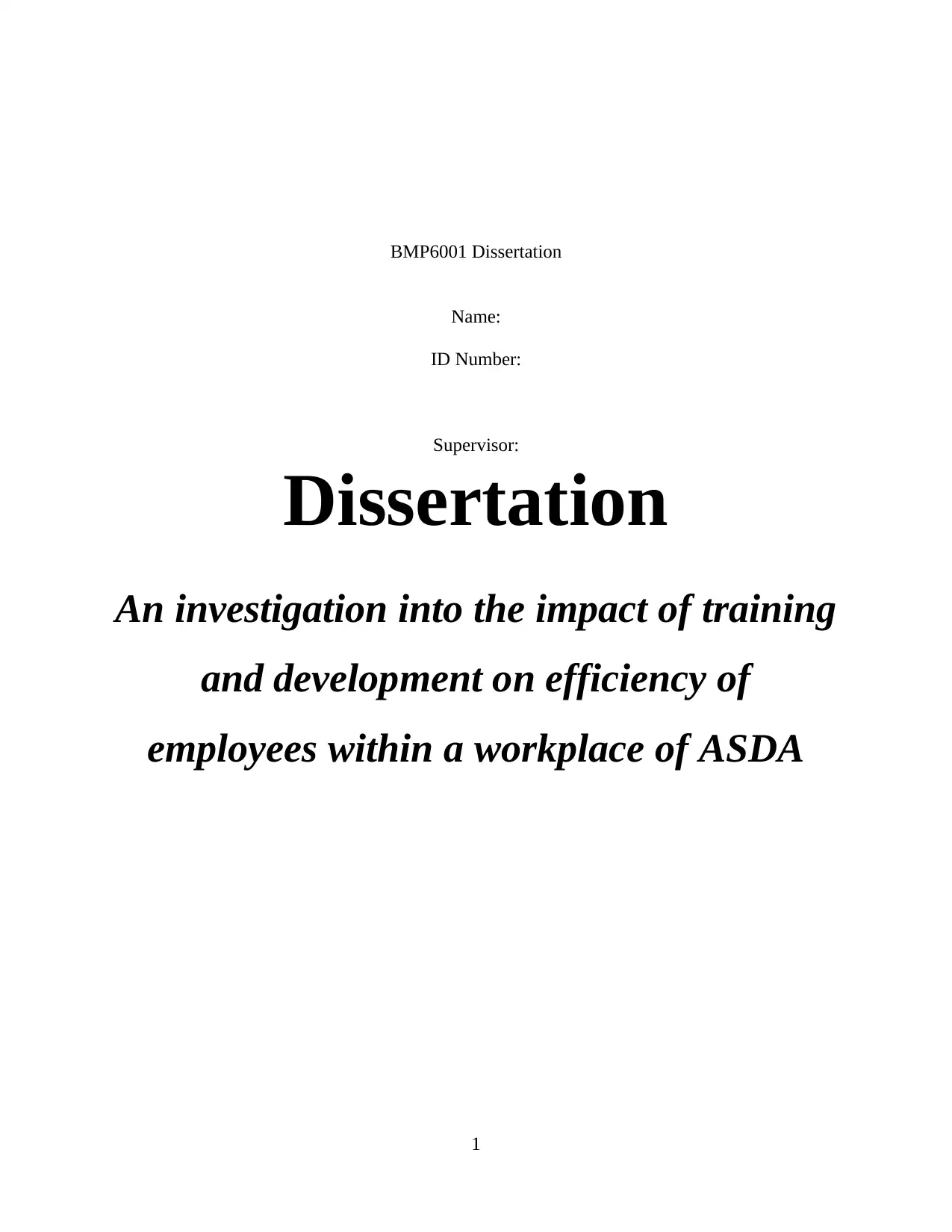
BMP6001 Dissertation
Name:
ID Number:
Supervisor:
Dissertation
An investigation into the impact of training
and development on efficiency of
employees within a workplace of ASDA
1
Name:
ID Number:
Supervisor:
Dissertation
An investigation into the impact of training
and development on efficiency of
employees within a workplace of ASDA
1
Paraphrase This Document
Need a fresh take? Get an instant paraphrase of this document with our AI Paraphraser
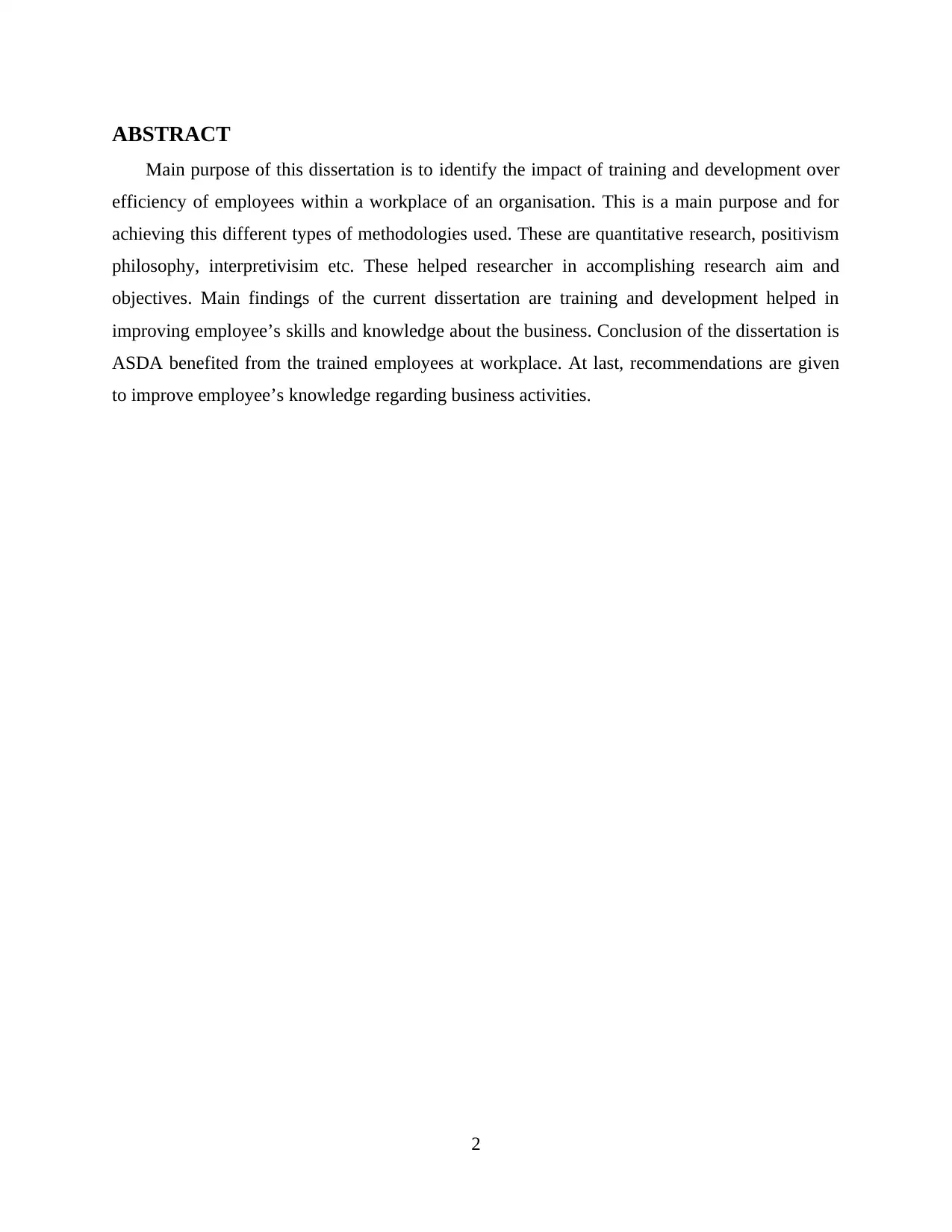
ABSTRACT
Main purpose of this dissertation is to identify the impact of training and development over
efficiency of employees within a workplace of an organisation. This is a main purpose and for
achieving this different types of methodologies used. These are quantitative research, positivism
philosophy, interpretivisim etc. These helped researcher in accomplishing research aim and
objectives. Main findings of the current dissertation are training and development helped in
improving employee’s skills and knowledge about the business. Conclusion of the dissertation is
ASDA benefited from the trained employees at workplace. At last, recommendations are given
to improve employee’s knowledge regarding business activities.
2
Main purpose of this dissertation is to identify the impact of training and development over
efficiency of employees within a workplace of an organisation. This is a main purpose and for
achieving this different types of methodologies used. These are quantitative research, positivism
philosophy, interpretivisim etc. These helped researcher in accomplishing research aim and
objectives. Main findings of the current dissertation are training and development helped in
improving employee’s skills and knowledge about the business. Conclusion of the dissertation is
ASDA benefited from the trained employees at workplace. At last, recommendations are given
to improve employee’s knowledge regarding business activities.
2
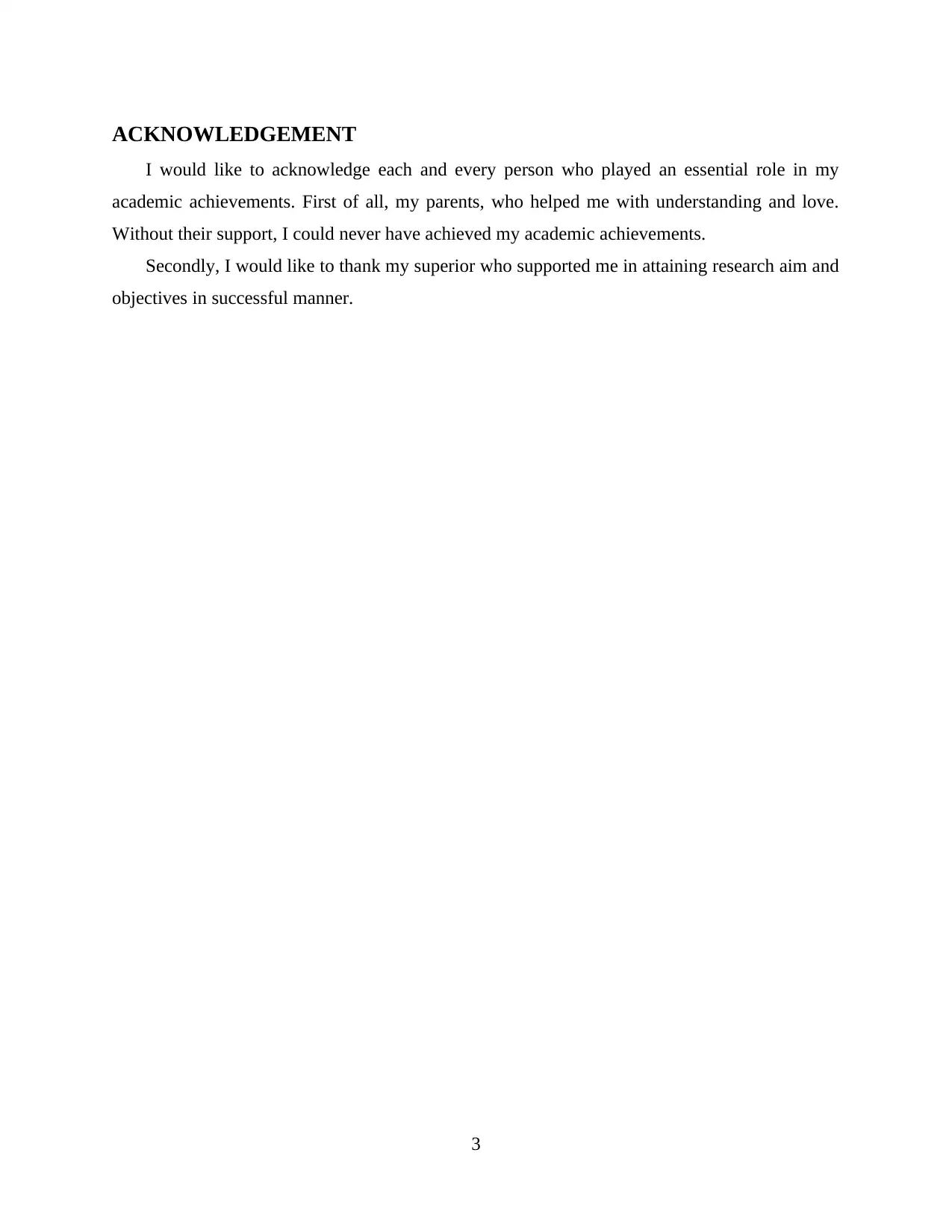
ACKNOWLEDGEMENT
I would like to acknowledge each and every person who played an essential role in my
academic achievements. First of all, my parents, who helped me with understanding and love.
Without their support, I could never have achieved my academic achievements.
Secondly, I would like to thank my superior who supported me in attaining research aim and
objectives in successful manner.
3
I would like to acknowledge each and every person who played an essential role in my
academic achievements. First of all, my parents, who helped me with understanding and love.
Without their support, I could never have achieved my academic achievements.
Secondly, I would like to thank my superior who supported me in attaining research aim and
objectives in successful manner.
3
⊘ This is a preview!⊘
Do you want full access?
Subscribe today to unlock all pages.

Trusted by 1+ million students worldwide

GLOSSARY
Arranged
Competency
Development
Organised
Performance
Probability Sampling
Quantitative Research
Training and Development
4
Arranged
Competency
Development
Organised
Performance
Probability Sampling
Quantitative Research
Training and Development
4
Paraphrase This Document
Need a fresh take? Get an instant paraphrase of this document with our AI Paraphraser
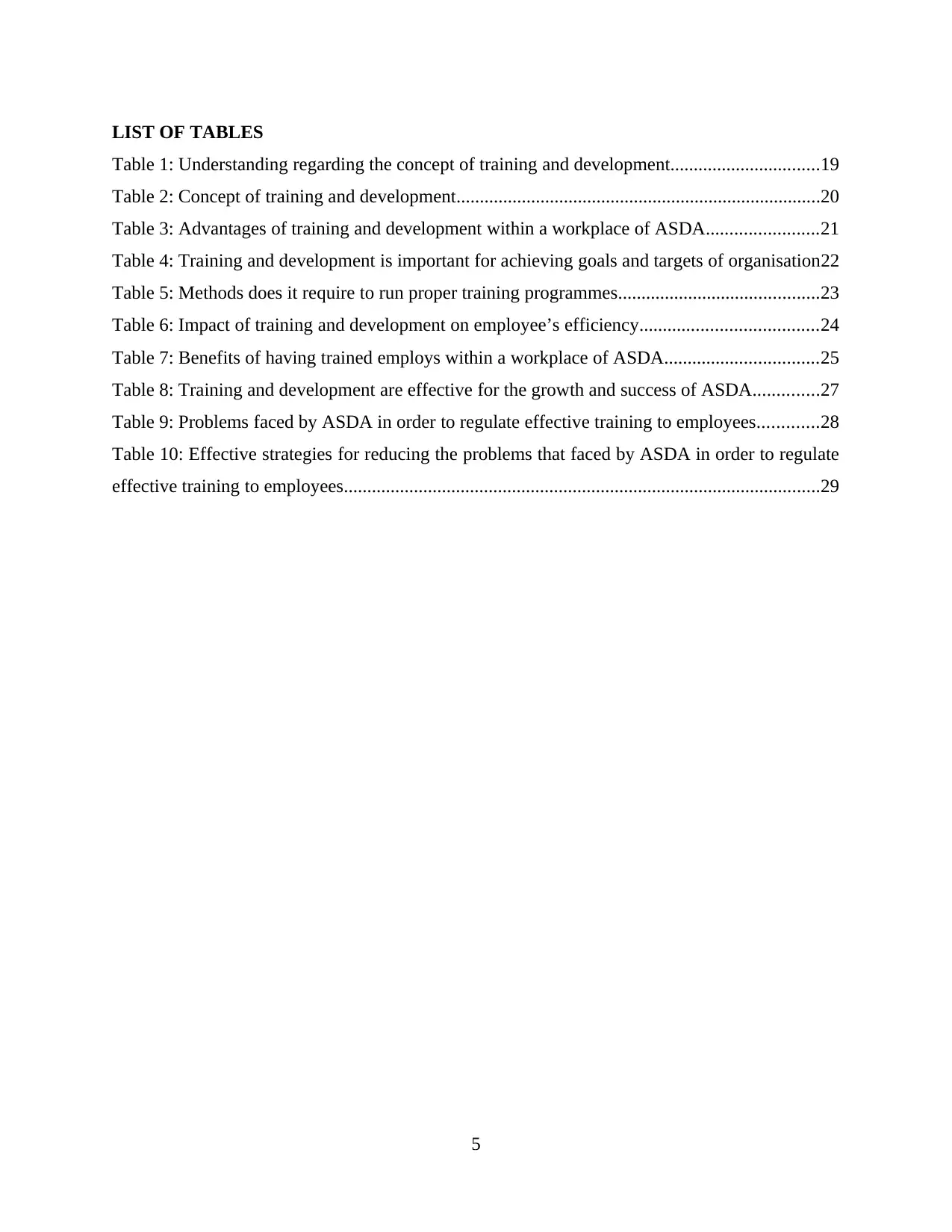
LIST OF TABLES
Table 1: Understanding regarding the concept of training and development................................19
Table 2: Concept of training and development..............................................................................20
Table 3: Advantages of training and development within a workplace of ASDA........................21
Table 4: Training and development is important for achieving goals and targets of organisation22
Table 5: Methods does it require to run proper training programmes...........................................23
Table 6: Impact of training and development on employee’s efficiency......................................24
Table 7: Benefits of having trained employs within a workplace of ASDA.................................25
Table 8: Training and development are effective for the growth and success of ASDA..............27
Table 9: Problems faced by ASDA in order to regulate effective training to employees.............28
Table 10: Effective strategies for reducing the problems that faced by ASDA in order to regulate
effective training to employees......................................................................................................29
5
Table 1: Understanding regarding the concept of training and development................................19
Table 2: Concept of training and development..............................................................................20
Table 3: Advantages of training and development within a workplace of ASDA........................21
Table 4: Training and development is important for achieving goals and targets of organisation22
Table 5: Methods does it require to run proper training programmes...........................................23
Table 6: Impact of training and development on employee’s efficiency......................................24
Table 7: Benefits of having trained employs within a workplace of ASDA.................................25
Table 8: Training and development are effective for the growth and success of ASDA..............27
Table 9: Problems faced by ASDA in order to regulate effective training to employees.............28
Table 10: Effective strategies for reducing the problems that faced by ASDA in order to regulate
effective training to employees......................................................................................................29
5
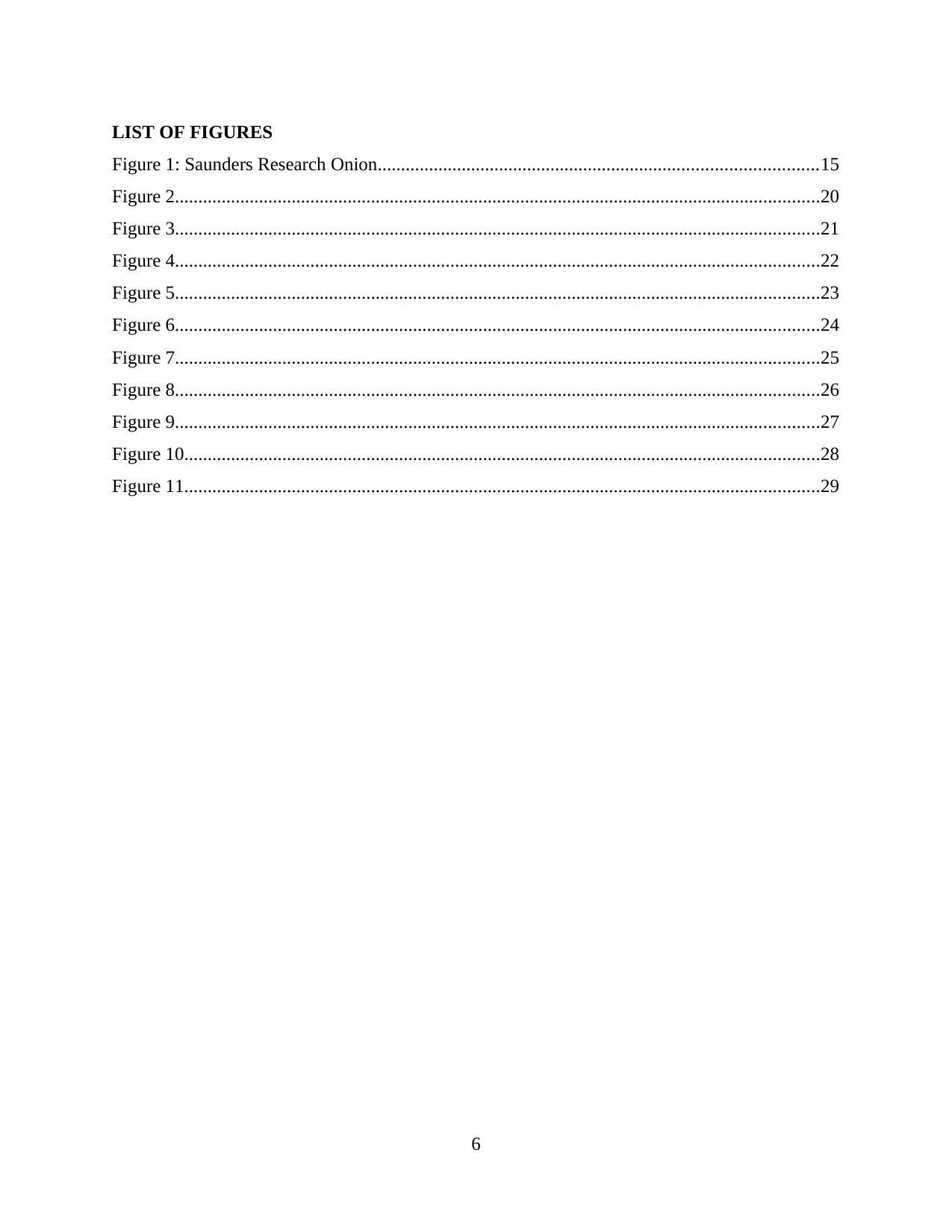
LIST OF FIGURES
Figure 1: Saunders Research Onion..............................................................................................15
Figure 2..........................................................................................................................................20
Figure 3..........................................................................................................................................21
Figure 4..........................................................................................................................................22
Figure 5..........................................................................................................................................23
Figure 6..........................................................................................................................................24
Figure 7..........................................................................................................................................25
Figure 8..........................................................................................................................................26
Figure 9..........................................................................................................................................27
Figure 10........................................................................................................................................28
Figure 11........................................................................................................................................29
6
Figure 1: Saunders Research Onion..............................................................................................15
Figure 2..........................................................................................................................................20
Figure 3..........................................................................................................................................21
Figure 4..........................................................................................................................................22
Figure 5..........................................................................................................................................23
Figure 6..........................................................................................................................................24
Figure 7..........................................................................................................................................25
Figure 8..........................................................................................................................................26
Figure 9..........................................................................................................................................27
Figure 10........................................................................................................................................28
Figure 11........................................................................................................................................29
6
⊘ This is a preview!⊘
Do you want full access?
Subscribe today to unlock all pages.

Trusted by 1+ million students worldwide
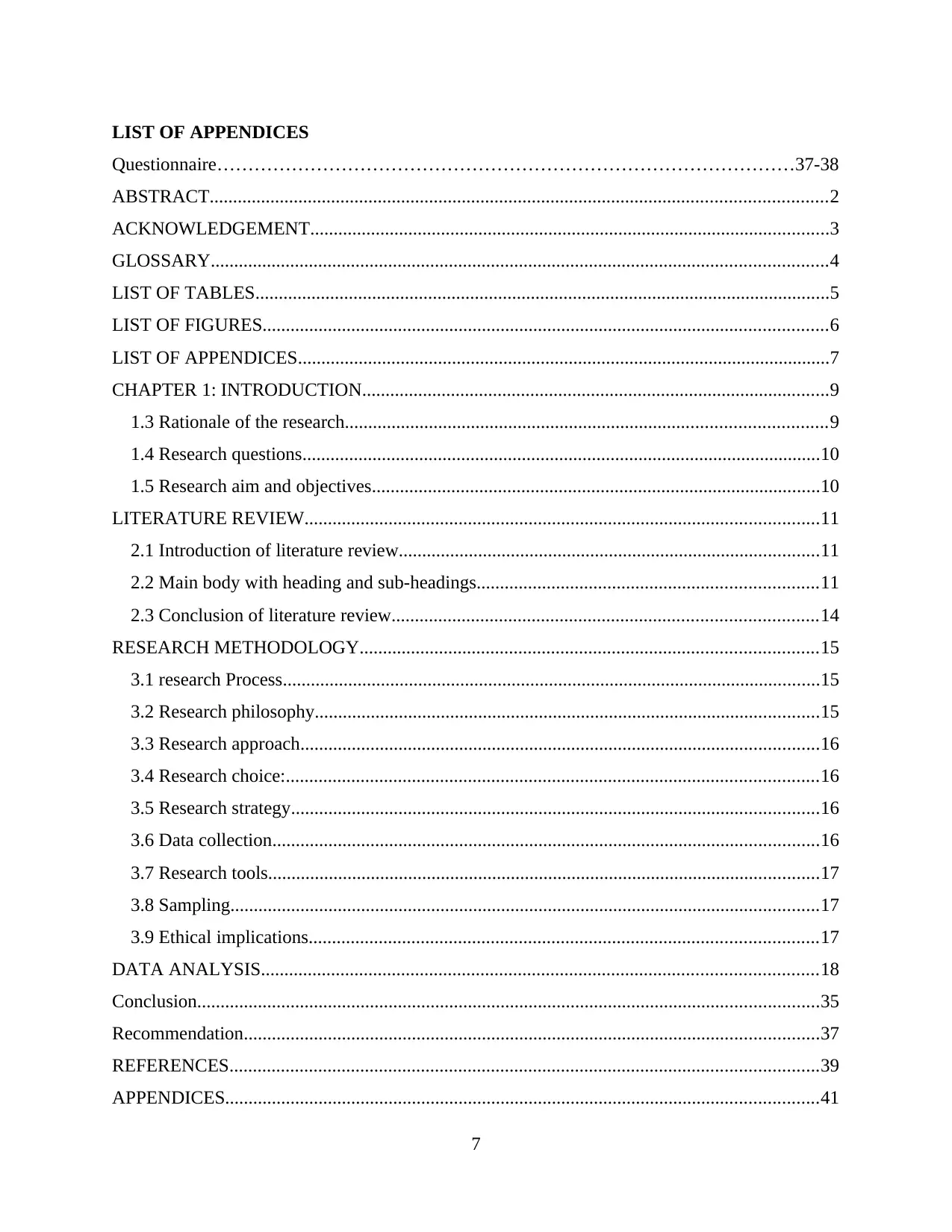
LIST OF APPENDICES
Questionnaire…………………………………………………………………………………37-38
ABSTRACT....................................................................................................................................2
ACKNOWLEDGEMENT...............................................................................................................3
GLOSSARY....................................................................................................................................4
LIST OF TABLES...........................................................................................................................5
LIST OF FIGURES.........................................................................................................................6
LIST OF APPENDICES..................................................................................................................7
CHAPTER 1: INTRODUCTION....................................................................................................9
1.3 Rationale of the research.......................................................................................................9
1.4 Research questions...............................................................................................................10
1.5 Research aim and objectives................................................................................................10
LITERATURE REVIEW..............................................................................................................11
2.1 Introduction of literature review..........................................................................................11
2.2 Main body with heading and sub-headings.........................................................................11
2.3 Conclusion of literature review...........................................................................................14
RESEARCH METHODOLOGY..................................................................................................15
3.1 research Process...................................................................................................................15
3.2 Research philosophy............................................................................................................15
3.3 Research approach...............................................................................................................16
3.4 Research choice:..................................................................................................................16
3.5 Research strategy.................................................................................................................16
3.6 Data collection.....................................................................................................................16
3.7 Research tools......................................................................................................................17
3.8 Sampling..............................................................................................................................17
3.9 Ethical implications.............................................................................................................17
DATA ANALYSIS.......................................................................................................................18
Conclusion.....................................................................................................................................35
Recommendation...........................................................................................................................37
REFERENCES..............................................................................................................................39
APPENDICES...............................................................................................................................41
7
Questionnaire…………………………………………………………………………………37-38
ABSTRACT....................................................................................................................................2
ACKNOWLEDGEMENT...............................................................................................................3
GLOSSARY....................................................................................................................................4
LIST OF TABLES...........................................................................................................................5
LIST OF FIGURES.........................................................................................................................6
LIST OF APPENDICES..................................................................................................................7
CHAPTER 1: INTRODUCTION....................................................................................................9
1.3 Rationale of the research.......................................................................................................9
1.4 Research questions...............................................................................................................10
1.5 Research aim and objectives................................................................................................10
LITERATURE REVIEW..............................................................................................................11
2.1 Introduction of literature review..........................................................................................11
2.2 Main body with heading and sub-headings.........................................................................11
2.3 Conclusion of literature review...........................................................................................14
RESEARCH METHODOLOGY..................................................................................................15
3.1 research Process...................................................................................................................15
3.2 Research philosophy............................................................................................................15
3.3 Research approach...............................................................................................................16
3.4 Research choice:..................................................................................................................16
3.5 Research strategy.................................................................................................................16
3.6 Data collection.....................................................................................................................16
3.7 Research tools......................................................................................................................17
3.8 Sampling..............................................................................................................................17
3.9 Ethical implications.............................................................................................................17
DATA ANALYSIS.......................................................................................................................18
Conclusion.....................................................................................................................................35
Recommendation...........................................................................................................................37
REFERENCES..............................................................................................................................39
APPENDICES...............................................................................................................................41
7
Paraphrase This Document
Need a fresh take? Get an instant paraphrase of this document with our AI Paraphraser

Questionnaire.............................................................................................................................41
8
8
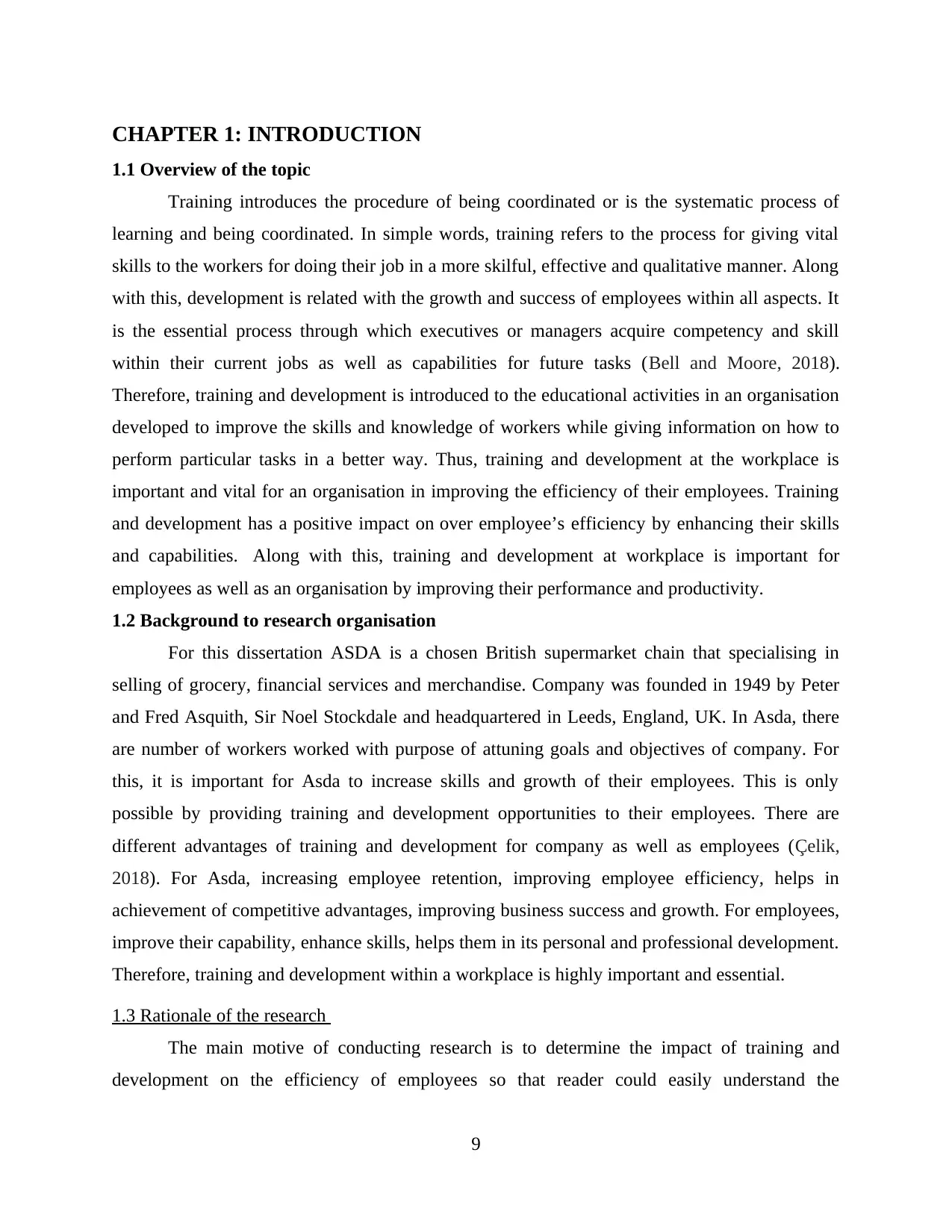
CHAPTER 1: INTRODUCTION
1.1 Overview of the topic
Training introduces the procedure of being coordinated or is the systematic process of
learning and being coordinated. In simple words, training refers to the process for giving vital
skills to the workers for doing their job in a more skilful, effective and qualitative manner. Along
with this, development is related with the growth and success of employees within all aspects. It
is the essential process through which executives or managers acquire competency and skill
within their current jobs as well as capabilities for future tasks (Bell and Moore, 2018).
Therefore, training and development is introduced to the educational activities in an organisation
developed to improve the skills and knowledge of workers while giving information on how to
perform particular tasks in a better way. Thus, training and development at the workplace is
important and vital for an organisation in improving the efficiency of their employees. Training
and development has a positive impact on over employee’s efficiency by enhancing their skills
and capabilities. Along with this, training and development at workplace is important for
employees as well as an organisation by improving their performance and productivity.
1.2 Background to research organisation
For this dissertation ASDA is a chosen British supermarket chain that specialising in
selling of grocery, financial services and merchandise. Company was founded in 1949 by Peter
and Fred Asquith, Sir Noel Stockdale and headquartered in Leeds, England, UK. In Asda, there
are number of workers worked with purpose of attuning goals and objectives of company. For
this, it is important for Asda to increase skills and growth of their employees. This is only
possible by providing training and development opportunities to their employees. There are
different advantages of training and development for company as well as employees (Çelik,
2018). For Asda, increasing employee retention, improving employee efficiency, helps in
achievement of competitive advantages, improving business success and growth. For employees,
improve their capability, enhance skills, helps them in its personal and professional development.
Therefore, training and development within a workplace is highly important and essential.
1.3 Rationale of the research
The main motive of conducting research is to determine the impact of training and
development on the efficiency of employees so that reader could easily understand the
9
1.1 Overview of the topic
Training introduces the procedure of being coordinated or is the systematic process of
learning and being coordinated. In simple words, training refers to the process for giving vital
skills to the workers for doing their job in a more skilful, effective and qualitative manner. Along
with this, development is related with the growth and success of employees within all aspects. It
is the essential process through which executives or managers acquire competency and skill
within their current jobs as well as capabilities for future tasks (Bell and Moore, 2018).
Therefore, training and development is introduced to the educational activities in an organisation
developed to improve the skills and knowledge of workers while giving information on how to
perform particular tasks in a better way. Thus, training and development at the workplace is
important and vital for an organisation in improving the efficiency of their employees. Training
and development has a positive impact on over employee’s efficiency by enhancing their skills
and capabilities. Along with this, training and development at workplace is important for
employees as well as an organisation by improving their performance and productivity.
1.2 Background to research organisation
For this dissertation ASDA is a chosen British supermarket chain that specialising in
selling of grocery, financial services and merchandise. Company was founded in 1949 by Peter
and Fred Asquith, Sir Noel Stockdale and headquartered in Leeds, England, UK. In Asda, there
are number of workers worked with purpose of attuning goals and objectives of company. For
this, it is important for Asda to increase skills and growth of their employees. This is only
possible by providing training and development opportunities to their employees. There are
different advantages of training and development for company as well as employees (Çelik,
2018). For Asda, increasing employee retention, improving employee efficiency, helps in
achievement of competitive advantages, improving business success and growth. For employees,
improve their capability, enhance skills, helps them in its personal and professional development.
Therefore, training and development within a workplace is highly important and essential.
1.3 Rationale of the research
The main motive of conducting research is to determine the impact of training and
development on the efficiency of employees so that reader could easily understand the
9
⊘ This is a preview!⊘
Do you want full access?
Subscribe today to unlock all pages.

Trusted by 1+ million students worldwide
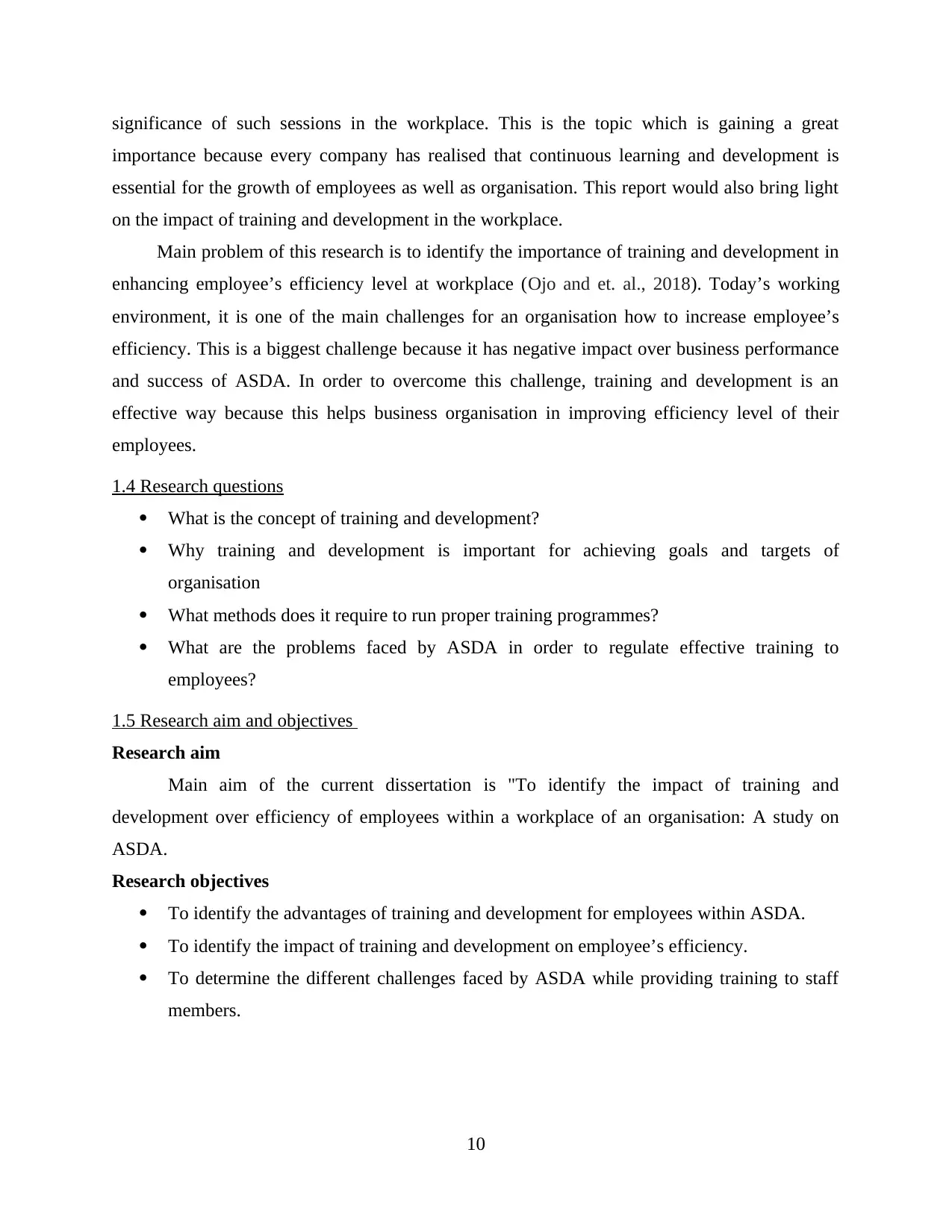
significance of such sessions in the workplace. This is the topic which is gaining a great
importance because every company has realised that continuous learning and development is
essential for the growth of employees as well as organisation. This report would also bring light
on the impact of training and development in the workplace.
Main problem of this research is to identify the importance of training and development in
enhancing employee’s efficiency level at workplace (Ojo and et. al., 2018). Today’s working
environment, it is one of the main challenges for an organisation how to increase employee’s
efficiency. This is a biggest challenge because it has negative impact over business performance
and success of ASDA. In order to overcome this challenge, training and development is an
effective way because this helps business organisation in improving efficiency level of their
employees.
1.4 Research questions
What is the concept of training and development?
Why training and development is important for achieving goals and targets of
organisation
What methods does it require to run proper training programmes?
What are the problems faced by ASDA in order to regulate effective training to
employees?
1.5 Research aim and objectives
Research aim
Main aim of the current dissertation is "To identify the impact of training and
development over efficiency of employees within a workplace of an organisation: A study on
ASDA.
Research objectives
To identify the advantages of training and development for employees within ASDA.
To identify the impact of training and development on employee’s efficiency.
To determine the different challenges faced by ASDA while providing training to staff
members.
10
importance because every company has realised that continuous learning and development is
essential for the growth of employees as well as organisation. This report would also bring light
on the impact of training and development in the workplace.
Main problem of this research is to identify the importance of training and development in
enhancing employee’s efficiency level at workplace (Ojo and et. al., 2018). Today’s working
environment, it is one of the main challenges for an organisation how to increase employee’s
efficiency. This is a biggest challenge because it has negative impact over business performance
and success of ASDA. In order to overcome this challenge, training and development is an
effective way because this helps business organisation in improving efficiency level of their
employees.
1.4 Research questions
What is the concept of training and development?
Why training and development is important for achieving goals and targets of
organisation
What methods does it require to run proper training programmes?
What are the problems faced by ASDA in order to regulate effective training to
employees?
1.5 Research aim and objectives
Research aim
Main aim of the current dissertation is "To identify the impact of training and
development over efficiency of employees within a workplace of an organisation: A study on
ASDA.
Research objectives
To identify the advantages of training and development for employees within ASDA.
To identify the impact of training and development on employee’s efficiency.
To determine the different challenges faced by ASDA while providing training to staff
members.
10
Paraphrase This Document
Need a fresh take? Get an instant paraphrase of this document with our AI Paraphraser
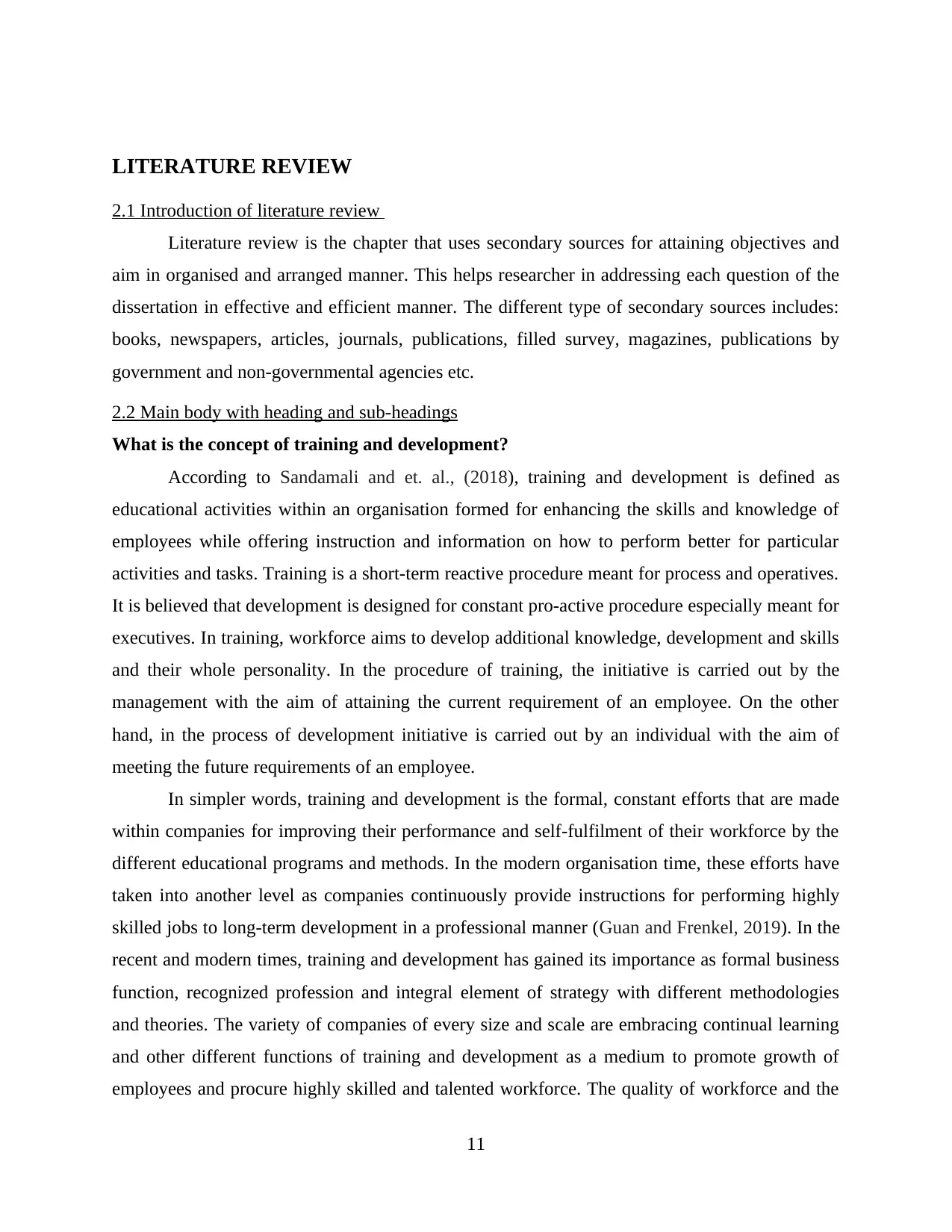
LITERATURE REVIEW
2.1 Introduction of literature review
Literature review is the chapter that uses secondary sources for attaining objectives and
aim in organised and arranged manner. This helps researcher in addressing each question of the
dissertation in effective and efficient manner. The different type of secondary sources includes:
books, newspapers, articles, journals, publications, filled survey, magazines, publications by
government and non-governmental agencies etc.
2.2 Main body with heading and sub-headings
What is the concept of training and development?
According to Sandamali and et. al., (2018), training and development is defined as
educational activities within an organisation formed for enhancing the skills and knowledge of
employees while offering instruction and information on how to perform better for particular
activities and tasks. Training is a short-term reactive procedure meant for process and operatives.
It is believed that development is designed for constant pro-active procedure especially meant for
executives. In training, workforce aims to develop additional knowledge, development and skills
and their whole personality. In the procedure of training, the initiative is carried out by the
management with the aim of attaining the current requirement of an employee. On the other
hand, in the process of development initiative is carried out by an individual with the aim of
meeting the future requirements of an employee.
In simpler words, training and development is the formal, constant efforts that are made
within companies for improving their performance and self-fulfilment of their workforce by the
different educational programs and methods. In the modern organisation time, these efforts have
taken into another level as companies continuously provide instructions for performing highly
skilled jobs to long-term development in a professional manner (Guan and Frenkel, 2019). In the
recent and modern times, training and development has gained its importance as formal business
function, recognized profession and integral element of strategy with different methodologies
and theories. The variety of companies of every size and scale are embracing continual learning
and other different functions of training and development as a medium to promote growth of
employees and procure highly skilled and talented workforce. The quality of workforce and the
11
2.1 Introduction of literature review
Literature review is the chapter that uses secondary sources for attaining objectives and
aim in organised and arranged manner. This helps researcher in addressing each question of the
dissertation in effective and efficient manner. The different type of secondary sources includes:
books, newspapers, articles, journals, publications, filled survey, magazines, publications by
government and non-governmental agencies etc.
2.2 Main body with heading and sub-headings
What is the concept of training and development?
According to Sandamali and et. al., (2018), training and development is defined as
educational activities within an organisation formed for enhancing the skills and knowledge of
employees while offering instruction and information on how to perform better for particular
activities and tasks. Training is a short-term reactive procedure meant for process and operatives.
It is believed that development is designed for constant pro-active procedure especially meant for
executives. In training, workforce aims to develop additional knowledge, development and skills
and their whole personality. In the procedure of training, the initiative is carried out by the
management with the aim of attaining the current requirement of an employee. On the other
hand, in the process of development initiative is carried out by an individual with the aim of
meeting the future requirements of an employee.
In simpler words, training and development is the formal, constant efforts that are made
within companies for improving their performance and self-fulfilment of their workforce by the
different educational programs and methods. In the modern organisation time, these efforts have
taken into another level as companies continuously provide instructions for performing highly
skilled jobs to long-term development in a professional manner (Guan and Frenkel, 2019). In the
recent and modern times, training and development has gained its importance as formal business
function, recognized profession and integral element of strategy with different methodologies
and theories. The variety of companies of every size and scale are embracing continual learning
and other different functions of training and development as a medium to promote growth of
employees and procure highly skilled and talented workforce. The quality of workforce and the
11
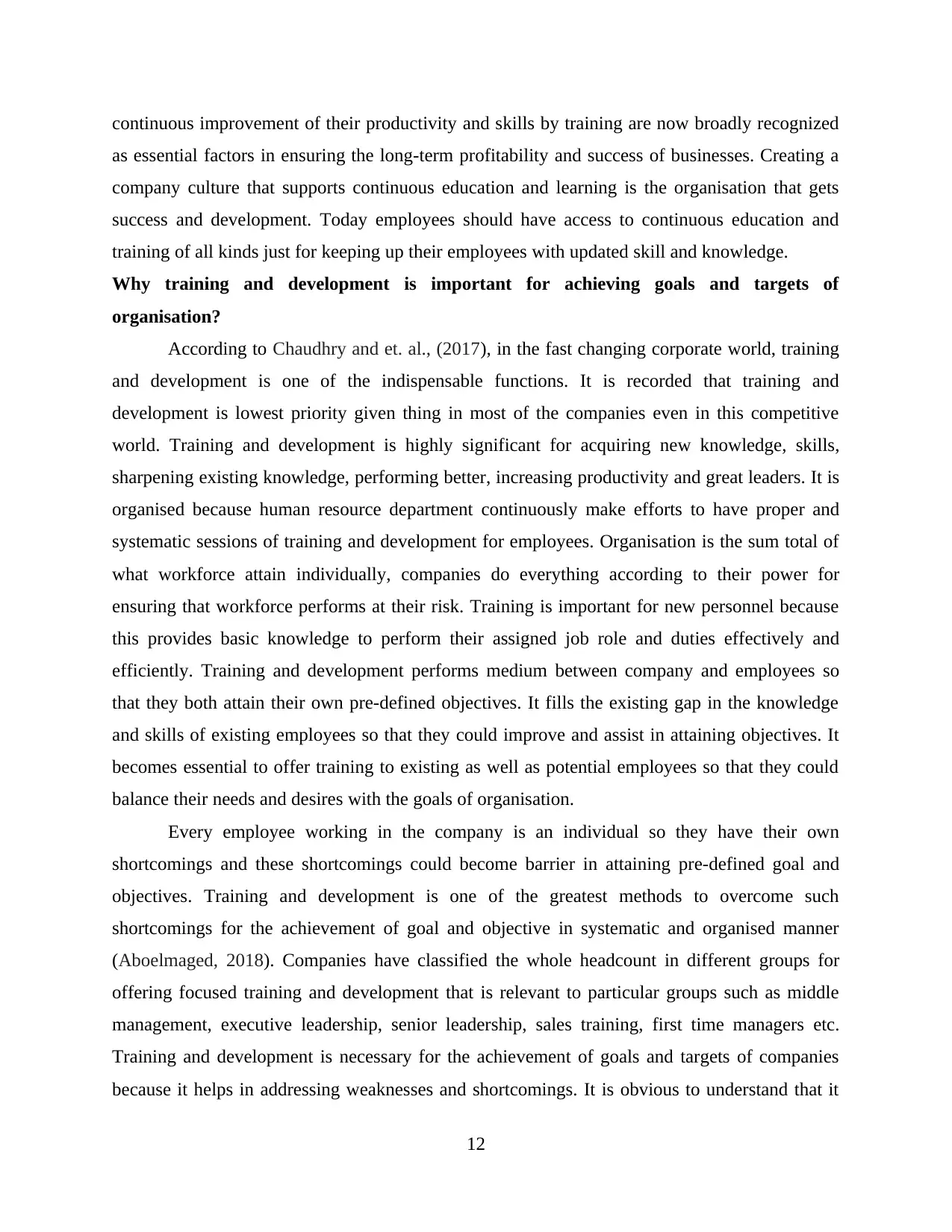
continuous improvement of their productivity and skills by training are now broadly recognized
as essential factors in ensuring the long-term profitability and success of businesses. Creating a
company culture that supports continuous education and learning is the organisation that gets
success and development. Today employees should have access to continuous education and
training of all kinds just for keeping up their employees with updated skill and knowledge.
Why training and development is important for achieving goals and targets of
organisation?
According to Chaudhry and et. al., (2017), in the fast changing corporate world, training
and development is one of the indispensable functions. It is recorded that training and
development is lowest priority given thing in most of the companies even in this competitive
world. Training and development is highly significant for acquiring new knowledge, skills,
sharpening existing knowledge, performing better, increasing productivity and great leaders. It is
organised because human resource department continuously make efforts to have proper and
systematic sessions of training and development for employees. Organisation is the sum total of
what workforce attain individually, companies do everything according to their power for
ensuring that workforce performs at their risk. Training is important for new personnel because
this provides basic knowledge to perform their assigned job role and duties effectively and
efficiently. Training and development performs medium between company and employees so
that they both attain their own pre-defined objectives. It fills the existing gap in the knowledge
and skills of existing employees so that they could improve and assist in attaining objectives. It
becomes essential to offer training to existing as well as potential employees so that they could
balance their needs and desires with the goals of organisation.
Every employee working in the company is an individual so they have their own
shortcomings and these shortcomings could become barrier in attaining pre-defined goal and
objectives. Training and development is one of the greatest methods to overcome such
shortcomings for the achievement of goal and objective in systematic and organised manner
(Aboelmaged, 2018). Companies have classified the whole headcount in different groups for
offering focused training and development that is relevant to particular groups such as middle
management, executive leadership, senior leadership, sales training, first time managers etc.
Training and development is necessary for the achievement of goals and targets of companies
because it helps in addressing weaknesses and shortcomings. It is obvious to understand that it
12
as essential factors in ensuring the long-term profitability and success of businesses. Creating a
company culture that supports continuous education and learning is the organisation that gets
success and development. Today employees should have access to continuous education and
training of all kinds just for keeping up their employees with updated skill and knowledge.
Why training and development is important for achieving goals and targets of
organisation?
According to Chaudhry and et. al., (2017), in the fast changing corporate world, training
and development is one of the indispensable functions. It is recorded that training and
development is lowest priority given thing in most of the companies even in this competitive
world. Training and development is highly significant for acquiring new knowledge, skills,
sharpening existing knowledge, performing better, increasing productivity and great leaders. It is
organised because human resource department continuously make efforts to have proper and
systematic sessions of training and development for employees. Organisation is the sum total of
what workforce attain individually, companies do everything according to their power for
ensuring that workforce performs at their risk. Training is important for new personnel because
this provides basic knowledge to perform their assigned job role and duties effectively and
efficiently. Training and development performs medium between company and employees so
that they both attain their own pre-defined objectives. It fills the existing gap in the knowledge
and skills of existing employees so that they could improve and assist in attaining objectives. It
becomes essential to offer training to existing as well as potential employees so that they could
balance their needs and desires with the goals of organisation.
Every employee working in the company is an individual so they have their own
shortcomings and these shortcomings could become barrier in attaining pre-defined goal and
objectives. Training and development is one of the greatest methods to overcome such
shortcomings for the achievement of goal and objective in systematic and organised manner
(Aboelmaged, 2018). Companies have classified the whole headcount in different groups for
offering focused training and development that is relevant to particular groups such as middle
management, executive leadership, senior leadership, sales training, first time managers etc.
Training and development is necessary for the achievement of goals and targets of companies
because it helps in addressing weaknesses and shortcomings. It is obvious to understand that it
12
⊘ This is a preview!⊘
Do you want full access?
Subscribe today to unlock all pages.

Trusted by 1+ million students worldwide
1 out of 42
Related Documents
Your All-in-One AI-Powered Toolkit for Academic Success.
+13062052269
info@desklib.com
Available 24*7 on WhatsApp / Email
![[object Object]](/_next/static/media/star-bottom.7253800d.svg)
Unlock your academic potential
Copyright © 2020–2025 A2Z Services. All Rights Reserved. Developed and managed by ZUCOL.





